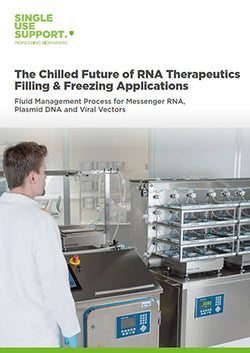Freezing mRNA: best practice
Freezing mRNA is a crucial step in messenger RNA manufacturing, balancing product quality, cost-effectiveness, process safety, and efficiency. Traditional methods can be inefficient and error-prone, while there are innovative solutions that can bring several advantages both for biopharma processes and the resulting products.
This article discusses best practices in freezing mRNA, including different freezing methods, the role of cryoprotectants, the impact of repeated freeze-thaw cycles on mRNA, the characterization of mRNA stability and a comparison of lyophilization, blast freezing, and plate freezing methods.
Finally, we will explore the latest single-use technologies for plate freezing mRNA to provide insights to optimizing mRNA manufacturing processes.
Special attention to freezing mRNA
Freezing mRNA is vital for maintaining the efficacy of mRNA-based products, such as the mRNA vaccines used in the pandemic for Coronavirus (COVID-19). The process requires advanced advanced technologies to ensure the viability of mRNA molecules. Biomanufacturers adhere to strict regulations on freezing and storage conditions to meet GMP relevant quality requirements.
Research conducted in the USA revealed that the mRNA quality of Comirnaty and Spikevax vaccines remained stable, even after a month of re-freezing and storage at temperatures of -20 °C or -80 °C. Biomanufacturers are well advised to optimize the cold chain process, thereby minimizing vaccine wastage. [[1]]
Thus, appropriate manufacturing processes, including equipment and regulatory compliance, are not only crucial in Coronavirus (COVID-19) mRNA vaccine storage, but for mRNA storage in general. [[1]]

What to consider when freezing mRNA
The process of freezing mRNA may sound simple, but it requires careful attention to a variety of factors.
From choosing the right cryoprotectants to understanding the implications of repeated freeze-thaw cycles, freezing mRNA is a nuanced procedure that demands a deep understanding of the biological and physical properties of mRNA.
Cryoprotectants and their role in mRNA freezing
Cryoprotectants, including phosphate-based compounds, are vital in mRNA freezing, especially when encapsulated within mrna-lipid nanoparticles (LNPs) that may contain ionizable lipid and protect the delicate nucleic acids. These substances safeguard the product during freezing, preventing potential damage that could compromise mRNA stability and effectiveness. The right selection is critical, as different types can have varying effects on LNPs and mRNA and mitigate the risk of hydrolysis.
In essence, cryoprotectants such as tris (tromethamine) and their evaluation through assays play a key role in preserving the integrity of mRNA and LNPs during freezing, significantly contributing to the success of mRNA-based synthesis products. Additionally, cryoprotectants can help to avoid the formation of ice crystals, which may affect the antibody binding sites on the encoding mRNA proteins, potentially impacting the immune response and enzymes generated by the vaccine.
Read more: Regulations for Cryoprotectants in ATMP Cryopreservation [[2]]
Repeated freezing and thawing – does it impact mRNA and the genome?
The integrity of mRNA could be compromised by multiple freeze-thaw cycles, especially in the case of mRNA-based Covid-19 vaccines such as those produced by Pfizer-Biontech and Moderna. These vaccines use lipid nanoparticles (LNPs) for encapsulation.
Understanding how freeze-thaw cycles affect these non-viral vector-based vaccines on a molecular level, specifically in the context of SARS-CoV-2, including the stability of mRNA delivery and the process of transcription, is still an ongoing investigation. This emphasizes the need for scientists to further investigate mRNA vaccines' integrity and efficacy in both in vitro and in vivo settings. [[3]]
Furthermore, the choice of appropriate freezing solutions, such as natural cryoprotectants, and maintaining the right pH using phosphate-buffered saline (PBS) can potentially mitigate the effects of freeze-thaw cycles on mRNA stability. [[3]]
Cost effectiveness and process safety
Achieving cost-effectiveness and process safety in mRNA manufacturing is a balancing act. Costs can rise due to storage temperature requirements, freezing equipment and energy demands, while process safety is paramount to avoid mRNA degradation and subsequent health risks.
Single-use technologies present a remedy by lowering costs and minimizing the chance of cross-contamination, thereby enhancing both efficiency and safety in the production of mRNA.

Different freezing methods for mRNA-based drug products
As we delve deeper into the realm of mRNA-based therapeutics like Covid-19 vaccines, it is essential to highlight the variety of freezing methods and the formulation considerations that play a pivotal role in preserving the integrity and efficacy of mRNA.
From the commonly employed blast freezing to the use of lyophilization, and the emerging technique of plate freezing, the choice of freezing method and the corresponding formulation can significantly impact the overall mRNA storage and use.
Blast freezing mRNA
Blast freezing is a commonly used technique for mRNA preservation, utilizing the circulation of cold air around frozen samples to keep them at ultra-low temperature.
This method aids in maintaining the integrity of mRNA, though it necessitates the use of specialized, high-priced freezers and could potentially result in the formation of larger ice crystals that might damage the mRNA.
Particularly when using bottles as primary packaging, the efficiency and effectiveness of controlled blast freezing makes it an essential tool in ensuring the stability and efficacy of mRNA-based pharmaceuticals.
mRNA and lyophilization
Lyophilization – or freeze drying – involves removing water from a product by first lowering temperature before lowering pressure. Any water present (now in a frozen state) can be removed via sublimation, which means that the ice directly passes to the gas phase.
Beneficial for long-term storage, it allows mRNA to be stable at room temperature, negating ultra-cold storage needs. However, it is time-consuming, requires specialized, expensive equipment, and poses a risk of contamination, product loss and mRNA degradation. [[4]] [[5]]
Plate freezing of mRNA
Plate freezing involves placing mRNA samples between two extremely cold plates, allowing for fast and controllable freezing rates. This method offers precise control over the freezing process, crucial for mRNA integrity and maintaining immunogenicity.
Plate freezing can help to avoid damaging effects that traditional freezing methods can have on mRNA products. For instance, this approach to freezing provides a significant advantage in avoiding the concentration effect, serving as an alternative to blast freezing.
The precision and speed of plate freezing make it an attractive option for mRNA preservation – several mRNA manufacturers rely on this technique.

Comparison: Lyophilization vs. blast freezing vs. plate freezing
A comparison of freezing methods and their impact on shelf life, quantification, statistical analysis, and reconstituted samples can provide valuable insights into the efficacy and integrity of mRNA preservation. Lyophilization, blast freezing, and plate freezing each bring their unique advantages and drawbacks to the mRNA preservation process.
Lyophilization, or freeze drying, is notable for enabling long-term storage at room temperature, a considerable advantage for logistical purposes. However, it is a time-consuming method requiring specialized, costly equipment and can risk product loss through mRNA degradation if not managed properly.
Blast freezing, on the other hand, provides steady freezing. Unless the blast freezing of mRNA in bottles is controlled, the slow freezing can lead to a risk of cryoconcentration and mRNA degradation, for example during phase transtition.
Plate freezing, however, shows significant differences with fast and controllable freezing rates. It provides a high degree of control over the freezing process with mRNA in single-use bags, reducing the risk of mRNA degradation and cryoconcentration. While it does require specialized equipment, the increased control over the process and the potential for better mRNA preservation make it a highly advantageous and beneficial method for mRNA freezing.

Best practice: Plate freezing mRNA with single-use technologies
In the realm of mRNA freezing, plate freezing coupled with single-use bioprocess containers emerges as a best practice, which is why plate freezers like those provided by Single Use Support are frequently used by mRNA manufacturers. The technique of plate freezing allows for fast, controllable freezing rates, significantly reducing risks associated with cryoconcentration and mRNA degradation.
Single-use technologies in mRNA manufacturing minimize the risk of cross-contamination and improve product viability, both key factors for maintaining the integrity of high quality mRNA in healthcare settings. Moreover, they offer a streamlined, automated process which reduces manual intervention, hence improving process safety. Importantly, single-use technologies can bring cost efficiencies by eliminating the need for cleaning and sterilization, and by reducing the overall footprint of the manufacturing setup.
Recognizing the myriad advantages of this approach, companies like Single Use Support have specialized in providing solutions that leverage plate freezing and single-use technologies. Their solutions address the key needs of the industry – cost-effectiveness, safety, speed, and automation –, making them a go-to choice for advanced messenger RNA manufacturing solutions.
- COVID-19 mRNA Vaccines Preserve Immunogenicity after Re-Freezing, http://dx.doi.org/10.3390/vaccines10040594, Published 2022-04-13
- Delivering the Messenger: Advances in Technologies for Therapeutic mRNA Delivery, http://dx.doi.org/10.1016/j.ymthe.2019.02.012, Published 2019-02-19
- Addressing the Cold Reality of mRNA Vaccine Stability, http://dx.doi.org/10.1016/j.xphs.2020.12.006, Published 2020-12-13
- Lyophilization provides long-term stability for a lipid nanoparticle-formulated, nucleoside-modified mRNA vaccine, http://dx.doi.org/10.1016/j.ymthe.2022.02.001, Published 2022-02-04
- Microencapsulation of Oils: A Comprehensive Review of Benefits, Techniques, and Applications. Comprehensive Reviews in Food Science and Food Safety. p. 143-182, https://, Published 2015

Download now
App Note: The Chilled Future of RNA Therapeutics Filling & Freezing Applications
This application note explores scalable, GMP-compatible solutions for the sterile filling and cryopreservation of mRNA, pDNA, and viral vectors. It presents modular technologies that ensure temperature control, minimize product loss, and support high-accuracy aliquotation - paving the way for efficient commercialization of RNA-based therapeutics.
